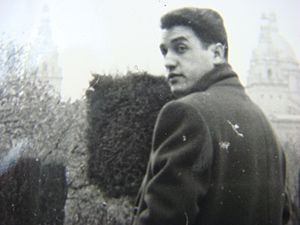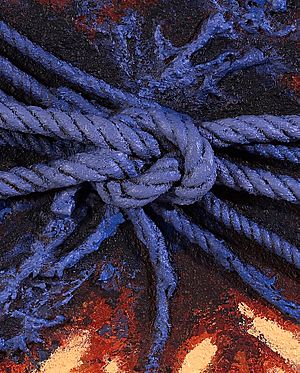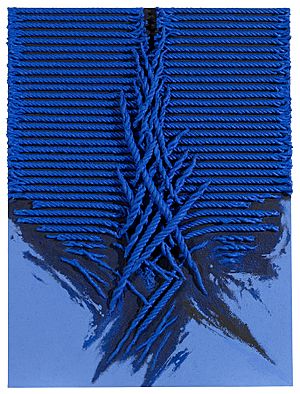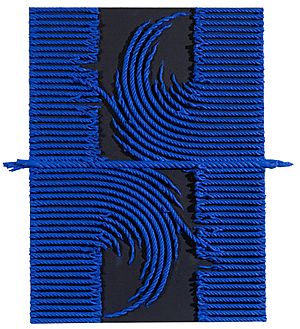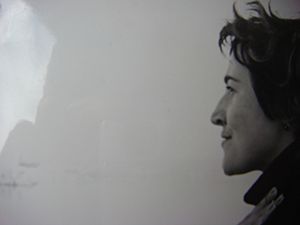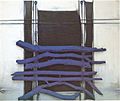Laurent Jiménez-Balaguer facts for kids
Quick facts for kids
Laurent Jiménez-Balaguer
|
|
|---|---|

Jiménez-Balaguer From Infinity to Infinity 2011
|
|
| Born |
Llorenç Jiménez-Balaguer
14 January 1928 |
| Died | 16 April 2015 (aged 87) |
| Nationality | Hispanic |
| Known for | painting |
|
Notable work
|
Clotted Memory, Through the Mirror N°23, The Crack of the World, What's hiding ? |
| Movement | Abstract Expressionism, Informalism, Humanism, Poststructuralism, Postmodernism, New Informalism |
Laurent Jiménez-Balaguer (14 January 1928 – 16 April 2015) Born in L’Hospitalet del Llobregat, Barcelona (Catalonia), Spain. He lived and worked in Paris. During the 1950s, he was one of the most distinguished painters of Catalan art, known for creating a private language. He belonged to the Abstract Expressionism and European Informalism. These postmodern vanguardists have been characterized by their multiculturalism, manifested in their contrasting pictorial textures, and the need to invent a new mindset.
Jiménez-Balaguer's purpose was to establish a framework of knowledge of the human psyche based on Ferdinand de Saussure's language model, in order to show how painting is a universal medium for the understanding of the Self. He regarded the construct of the Self as indispensable, and its visualization as vital; the human inner is neither an impalpable, untouchable soul nor an invisible, immaterial ego.
His conception of creation and society involves him in a process of a permanent revolution, from which the subject must struggle for the construction of the Self.
His work asserts that the Self is a performative act. Jose María Moreno Galván in 1960 considered him one of the twenty most talented painters of Contemporary Catalan Art.
Two fundamental archetypes structure his field: the Body-Memory and the Exterior-Interior.
Contents
Early years
Early on, Jiménez-Balaguer paints androgynous figures that exude a metaphysical sentiment.
His portraits emphasize what is within, unmarked by gender or cultural identity. Like El Greco, one of his artistic references, he seeks the transcendental essence of being. In 1955, he abandons all description of the world in order to focus on the problem of transforming the invisible to visible. He considers that painting allows for true knowledge of oneself, with the projection of raw material.
Following the parameters of Western philosophy, he thinks that all expression is an expression of something; therefore, the sign refers to a reality that constructs the object at the same time as the meaning.
According to this tradition, everything is related and has its corresponding channels: everything is connected and meaning is constructed by analogy.
His concept of Other Reality arises from here, as well as his work regarding boundaries and the concept of limit.
The real, understood symbolically, is found between the Interior and the Exterior, between Corporality and Memory. One of his most important contribution to Catalan Informalism and 21st century painting is referencing this 'Other Reality' as a linguistic-pictorial sign.
During these formative years, surrounded by political turmoil, he actively participates in the recognition of a Catalan identity. He learns to write in his language, Catalan, which was prohibited in Francoist Spain.
It is years of experimentation for the painter as he works on the hidden matter, that which one keeps inside one's psyche: the fragile and subjective.
Jiménez-Balaguer believes: "That which is sensed is a reflection of the intelligible", and he does not cease searching for the fundamental concept of individuation and independence.
Catalan Lyrical Abstraction
At the age of twenty, he goes to the mountains of the monastery in Montserrat and begins to paint with his friend, Josep Guinovart, experimenting a new freedom and liberating himself of the contingency of convention. He meets Cesáreo Rodríguez-Aguilera and his wife Mercedes de Prat, and a close friendship ensues.
He publishes a manifesto, He Escuchado, whereby he defines his aspirations along the vein of Stanley Cavell: 'Claim is what a voice does when it founds within itself in order to establish a universal assertion.'
His sensibilities are along the lines of Merleau-Ponty regarding his defense of the body as the subject, and Wittgenstein: 'The human body is the best image of the human soul.'
He exhibits in Ciclo Experimental d’Art Nou directed by Josep Maria de Sucre i de Grau and Angel Marsá and his paintings enrich the contemporary Catalan art scene. At the Galería Clan in Madrid, he receives the invaluable support of Manolo Millares, El Paso (grupo) and César Manrique, the latter becoming a good friend and inviting him to continue their contact. The goal is to impede the obstruction of expression and obtain total freedom of the Self. In 1956, the art critic Juan-Eduardo Cirlot includes him in the Art Informal movement.
Catalan identity is in search of specificity, and is in opposition to the official art sanctioned by Francoist Spain. The painters of the 20th century, mainly Joan Miró, insist on the need for a new art.
In 1957, in the European May Salons, intellectuals such as Antoni Tàpies and Laurent Jiménez-Balaguer, present their latest works. All the Informalist painters evince a critical vision against a world of oppression and exclusion, dominated by diverse imperialisms.
Informalism and Information
In the 1970s, in dialogue with the poststructuralist period, he continues to explore the possibilities of a knowledge of the Self. From then on, his work heralds a new period based on the understanding of the problem of human expression and its inabilities, inhibitions, prohibitions, and negations; Jiménez-Balaguer's paintings are a projection of the visualization of the unknown Inner.
In spite of the abstraction of the images, he finds no reason they would be mysterious, magical nor mute; instead, they should be able to communicate meaning. The utility of a sign, is its power to give universal information that allows giving the subject more power.
Although, Inform in Catalan language, is that which has no form, Jiménez-Balaguer chooses to investigate the second meaning of the word. As all words, 'inform' is not a univocal concept but a polysemous one. 'Inform' is also an exhaustive and organized exposition regarding a topic.
Therefore, according to Jiménez-Balaguer, Informal is telling information that still has no form, and Informalism is the science of the formation of the meaning. Informalism becomes, from this perspective, the artistic current that visualizes the space where significance is built.
In Defense of Subjectivity
His work demonstrates a deep respect for vulnerability. It is constructed as a critique against contemporary society that produces the destruction of subjectivity. During these years, Jiménez-Balaguer concerns himself with the power of painting as force.
He thinks that the informalist image bears witness to a semiotic pre-symbolic memory.
It is during this time that he frees himself from the destruction of the 1950s and the scratchings of postwar Informalism, in order to step into the 21st century.
As such, after the amputations, the fragmentation of the image, the details of the wound, the assimilation of negativity and violence exercised against the matter of the Self, there is the human psyche that is capable of reconstructing itself.
Jiménez-Balaguer focuses his art on the transformation of violence into Form.
Constitution of a universal language of the Self
During the 1960s, Jiménez-Balaguer and his wife María Teresa Andreu (Mery) relocate to Paris and establish themselves in the intellectual milieu. They have four children, Cristian, Virginie, Valérie and Eric. He meets the Parisian jeweler, Jean Vendome.
In 1961, he is introduced to Antoni Clavé and Stephen Spender from Gallery Saint-Germain. From then on and for the next twenty years, he develops a language of signs able to communicate the universal language of the Self.
As such, it is a deconstruction of the idea that a private language cannot be understood by another.
For Jiménez-Balaguer, the Inner has as a destiny: universal communication. In 1986, he meets Michel Tapié, the originator of the concept 'Art Autre' and he is introduced to Rodolphe Stadler.
From 1988 onward, he introduces a series of objects of the world in order to express the inward. His paintings become an enunciation with branches, ropes, cloth, grids, and nails.
Painting as interface
Jiménez-Balaguer's work gains the approbation and support of Pierre Restany and is introduced to Joan Hernández-Pijuan at the Galeria Calart Actual in Geneva.
From 1990, Laurent Jiménez-Balaguer devises the first system of signs for a universal language of the Inner. Each painting becomes the space for the visualization of the universal language of the Self from which the construction of the subject is confirmed.
His work questions the classic attributes of the subject: time, acquired memory, and suffering. His works enquire on such elements.
In 2000, he begins his philosophical dialogues with Alexis Virginie Jimenez on Catalan Art and Informalism; together, they create the artistic movement known as New Informalism. The movement begins in the year 2000 in his studio in Chevry II, in Gif sur Yvettes.
The theoretical base is related to the New Cultural studies. Alexis Virginie Jimenez's art videos, ‘Interventions’, are taped there.
Jiménez-Balaguer's work shares certain core values intrinsic to the field of Cultural studies and the theoretical struggle of intellectuals such as Julia Kristeva, Jacques Derrida, Gilles Deleuze, Jacques Lacan, Michel Foucault, Alexis Virginie Jimenez, Judith Butler.
The artist questions what to do with the cardinal points of Western metaphysics and how to interpret a new vision of the human identity.
Artwork : Universal graphic lexicon
The ropes: symbolize the ties that unite the invisible Inner of man to the universal Totality. 'The rope is an emblematic material of the road that brings the artist to the territory of Informalism's Art Autre.'
Blue branches: symbol of the wanderings of the soul and its realization in a unitarian form.
The knots: these are psycho-noetic strokes of subjective elaboration.
See also
- Informalism
- Western painting
Individual exhibitions
- 2012
Cicle Invasions Subtils amb Laurent Jiménez-Balaguer, Fundació Espai Guinovart, Agramunt – CATALONIA – SPAIN
- 2012
L’Emergència del Signe, Museo Can Framis, Fundació Vila Casas, Barcelona – CATALONIA – SPAIN
- 2010
"El Cos d’una memòria", Galeria Art Vall, Andorra la Vella – ANDORRA
- 2010
"Le Nœud", Galerie Saint Cyr, Rouen – FRANCE
- 2007
"Cuerpo de una memoria", Galeria Calart Actual, Segovia – SPAIN
- 2006
"L'au-delà du miroir", Galerie Guislain-États d'Art, Paris – FRANCE
- 2003
"Œuvres de 1960 à 1962" et "Souvenirs enfouis", Rétrospective, Galerie Guislain-États d'Art, Paris – FRANCE
- 2002
"Traces d'une mémoire", Centre d'Études Catalanes, Paris – FRANCE
- 2000
"Exposition", Galerie Guislain-États d'Art, Paris – FRANCE
- 1999
"2000 ans de quoi ?", Galerie Lina Davidov, Paris – FRANCE
- 1999
"2000 ans de quoi ?", Grand Théâtre d’Angers, Angers – FRANCE
- 1998
"Dedans/Dehors", La Corderie Royale, Rochefort – FRANCE
- 1998
MPT Courdimanche, Les Ulis – FRANCE
- 1997
"Images d'une mémoire", Les Cordeliers, Châteauroux – FRANCE
- 1997
Galerie Lina Davidov, Paris – FRANCE
- 1996
Galerie Finartis, Zug – SWITZERLAND
- 1995
Galerie Calart, Genève – SWITZERLAND
- 1994
Galerie Rami, Zurich – SWITZERLAND
- 1994
Galerie Lina Davidov, Paris – FRANCE
- 1993
Galerie Adriana Schmidt, Cologne – GERMANY
- 1992
Galerie Lina Davidov, Paris – FRANCE
- 1992
Galerie Adriana Schmidt, Stuttgart – GERMANY
- 1991
Centre d'Art Contemporain, Corbeil-Essonnes – FRANCE
- 1991
Galerie Claude Samuel, Paris – FRANCE
- 1991
Galerie Rami, Zurich – SWITZERLAND
- 1990
Galerie Calart, Genève – SWITZERLAND
- 1989
Galerie Claude Samuel, Paris – FRANCE
- 1987
"Réalité autre", Galerie Claude Samuel, Paris – FRANCE
- 1985
Paris Art Center, Paris – FRANCE
- 1984
Grand Orient de France, Paris – FRANCE
- 1982
International Arts Gallery, Chicago – UNITED STATES
- 1981
Galerie Vienner, Paris – FRANCE
- 1980
Galerie Vienner, Paris – FRANCE
- 1980
Musée Napoléonien, Antibes-Golfe-Juan – FRANCE
- 1979
Galerie Vienner, Paris – FRANCE
- 1977
Réalisation de huit grandes créations murales pour le Centre Hospitalier de Creil, Creil – FRANCE
- 1969
Dayton's Gallery 12, Minneapolis – UNITED STATES
- 1963
Joachim Gallery, Chicago – UNITED STATES
- 1961
Galerie Saint-Germain, Paris – FRANCE
- 1961
Savage Gallery, London – UNITED KINGDOM
- 1961
Galerie Toulouse, Copenhagen – DENMARK
- 1959
Galerie J.C. de Chaudun, Paris – FRANCE
- 1959
Galerie Mistral, Brussels – BELGIUM
- 1959
Centre Culturel et Artistique d'Uccle, Brussels – BELGIUM
- 1957
Club Universitari de València, Valencia – SPAIN
- 1957
Galeria d'Art Jaimes, Barcelona – CATALONIA – SPAIN
- 1956
Galeria Clan, Madrid – SPAIN
- 1956
Galeria d'Art Quint, Palma de Mallorca – Balearic Islands – SPAIN
- 1955
"Ciclo Experimental d’Art Nou", Galeries Jardin, Barcelona – CATALONIA – SPAIN
- 1955
Casino de Ripoll, Ripoll – SPAIN
- 1955
Galeries Laietanes, Barcelona – CATALONIA – SPAIN
- 1955
Galeria Sur, Santander – SPAIN
Retrospectives
- Fundació Vila Casas, Can Framis, Barcelona – Spain
Museums/Public collections
- Museu de l’Hospitalet, Barcelona – Spain
- Museu de Montserrat, Barcelona – Spain
- Fundació Vila Casas, Barcelona – Spain
- MACBA, Museu d’Art Contemporani, Barcelona – Spain
- Fons d'Art de la Generalitat de Catalunya, Barcelona – Spain
- Museu de Ceràmicas, Manises – Spain
- Artecovi, Fundación, Madrid – Spain
- Musée de Chateauroux, France
- Musée municipal de Bourg-en-Bresse, France
- Musée d’Art et Histoire, Rochefort – France
- Grand Théâtre (Angers), France
- Centre d'art sacré contemporain de Lille, France


